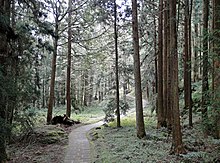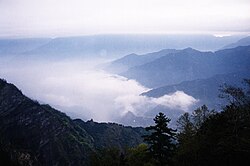Alishan National Scenic Area
This article needs additional citations for verification. (November 2016) |
| Alishan National Scenic Area | |||||||||||
|---|---|---|---|---|---|---|---|---|---|---|---|
 | |||||||||||
| Chinese | 阿里山國家風景區 | ||||||||||
| |||||||||||
23°31′N 120°48′E / 23.517°N 120.800°E
The Alishan National Scenic Area is a mountain resort and natural preserve located in the mountains of Chiayi County in Taiwan.[citation needed]
Geography


Alishan is 415 square kilometres (41,500 ha) in area. Notable characteristics include mountain wilderness, four villages, waterfalls, high altitude tea plantations, the Alishan Forest Railway, and a number of hiking trails. The area is popular with tourists and mountain climbers. Alishan, or Mount Ali, itself has become one of the major landmarks associated with Taiwan. The area is famous for its production of high mountain tea and wasabi.[citation needed]
Alishan is well known for its sunrises, and on a suitable morning one can observe the sun come up on a sea of clouds in the area between Alishan and Yüshan. Alishan and Sun Moon Lake are two of the best known scenic spots in Asia. The indigenous people of the area, the Thao people, have only recently been recognized as a discreet ethnic group. They have long been confused with the Thao people.[clarification needed][citation needed]
Climate
Alishan National Scenic Area spans a broad range in altitude. Lower elevations, such as in Leye Township, share the same subtropical and tropical climate as the rest of southern Taiwan, while the climate changes to temperate and alpine as the elevation increases. Snow sometimes falls at higher elevations in the winter.[citation needed]
Alishan National Scenic Area covers most, but not all, of Alishan Rural Township in Chiayi County, as well as parts of neighboring townships.[citation needed]
Average temperatures are relatively moderate:[citation needed]
- Low elevations: 24 °C in the summer, 16 °C in the winter.
- Medium elevations: 19 °C in the summer, 12 °C in the winter.
- High elevations: 14 °C in the summer, 5 °C in the winter.
Topography
Alishan is mountainous:[citation needed]
- Number of peaks above 2000 meters: 25
- Highest point: Da Ta Shan (大塔山), 2,663 meters.
- Average height of Alishan Mountain Range: 2,500 meters.
Vegetation and wildlife
Important trees in the area include:[citation needed]
- Taiwania cryptomerioides, a large coniferous tree in the cypress family Cupressaceae (the same family as the next three species)
- Chamaecyparis formosensis, or Formosan Cypress
- Chamaecyparis taiwanensis
- Cunninghamia konishii
- Pinus taiwanensis, or Taiwan Red Pine
- Picea morrisonicola, or Yüshan Spruce
- Pseudotsuga sinensis var. wilsoniana, or Taiwan Douglas-fir
- Abies kawakamii, a species of conifer in the Pinaceae family, only found in Taiwan
- Tsuga chinensis var. formosana, Taiwan or Chinese Hemlock
- Ulmus uyematsui, a species of elm only found in the Alishan region
History


The Alishan area was originally settled by the Tsou tribe of the Taiwanese aborigines; the name derives from the aboriginal word Jarissang. Ethnic Han Chinese settlers first settled on the plains near modern-day Chiayi as early as the late Ming Dynasty (around the mid-17th century), but did not move into the mountains until the late 18th century, establishing the towns of Ruili (瑞里), Ruifeng (瑞峰), Xiding (隙頂), and Fenqihu (奮起湖). The resulting armed clashes between the settlers and the aborigines pushed the aborigines even further into the mountains.[citation needed]
Following the cession of Taiwan to Japan at the end of the First Sino-Japanese War, Japanese expeditions to the area found large quantities of cypress (檜木, or hinoki in Japanese). This led to the development of the logging industry in the area and the export of local cypress and Taiwania wood. A series of narrow-gauge railways were built in the area during this time to facilitate the transportation of lumber from the mountains to the plains below, part of which continues to operate as the Alishan Forest Railway. Several new villages also began to sprout up along the railway lines. It was also during this time that the first tourists began to visit the area. Plans were even drawn up to incorporate the area into the new Niitaka (New Highest) Arisan National Park (新高阿里山国立公園).[citation needed]
With the exhaustion of forest resources by the 1970s, domestic and international tourism overtook logging to become the primary economic activity in the area. The tourism industry continued to expand with the completion of the Alisan highway in the 1980s, displacing the railroad as the primary mode of transportation up the mountain. To combat the problems associated with the growing crowds of tourists and the expanding tea and wasabi plantations, the area was declared a national scenic area in 2001.[citation needed]
On 1 December 2014, fire broke out at Alishan spreading over more than 5 hectares of land. The area affected was located near Tapang No. 3 Bridge. The fire was believed to happen due to dry ground which was vulnerable to fire because of the absence of rain in the area for months.[1]
Attractions and landmarks

Fenqihu (奮起湖) is a small town of low wooden buildings built into the mountainside at 1,400 meters, midpoint of the Alishan Forest Railway. It is famous for natural rock formations, mountain streams, forests, and the ruins of a Shinto temple in the vicinity, as well as for its production of high altitude food products such as bamboo shoots and aiyu jelly (愛玉). The local box lunches (奮起湖便當, Fenqihu bento), which were once sold to passengers on the rail line, are also well known.[citation needed]
The song Ālǐshān de gūniang (Chinese: 阿里山的姑娘; English: The Girls of Alishan), which refers to the beautiful[opinion] girls of the Tsou aboriginal tribe, is one of Taiwan's most popular folk songs. This song is also well known in China and several foreign countries, even though the people in the Alishan area are Thao.[citation needed]
See also
- List of national parks in Taiwan
- Alishan Range
- Alishan Forest Railway
- List of tourist attractions in Taiwan
